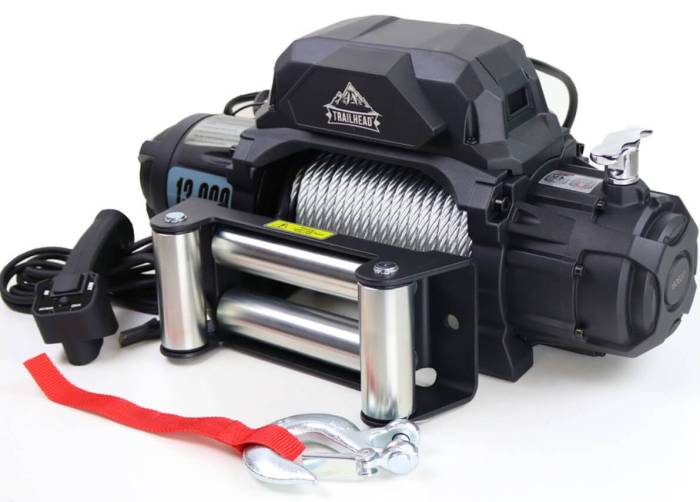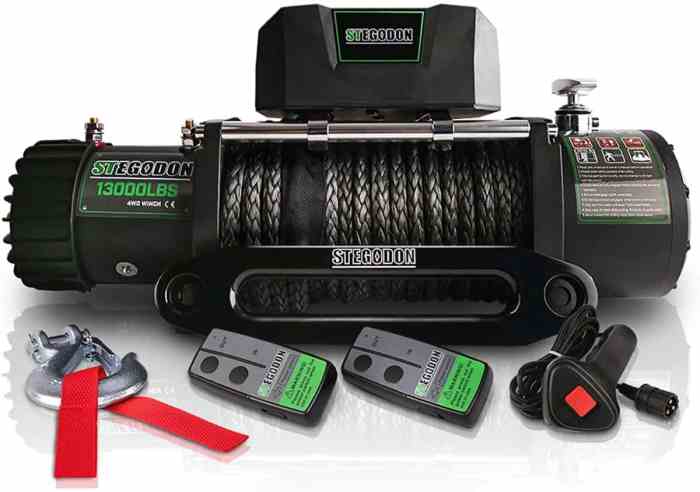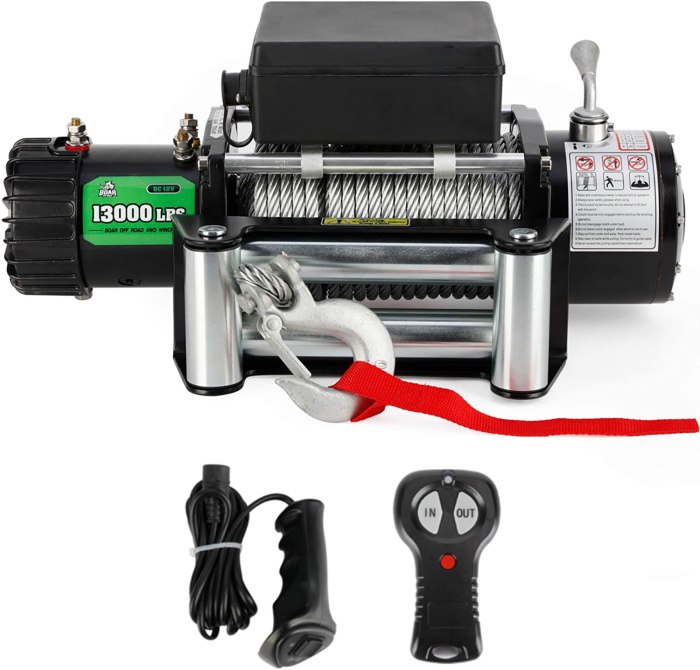Jeep winch systems represent a crucial element for off-road enthusiasts, providing the power and capability to overcome challenging obstacles. This guide delves into the intricacies of these systems, exploring their various components, installation processes, and practical applications. We’ll examine different winch types, their respective strengths and weaknesses, and offer advice on selecting the optimal system for your specific needs and driving style.
Understanding the proper usage and maintenance of a Jeep winch system is paramount for both safety and longevity. We’ll cover essential safety precautions, techniques for efficient winching, and routine maintenance procedures to ensure your winch remains a reliable asset on your off-road adventures. From choosing the right rope to understanding proper anchoring techniques, this guide provides a comprehensive overview.
For Jeep enthusiasts venturing off-road, a winch is more than just a helpful accessory; it’s often considered essential safety equipment. A robust winch system can be the difference between a successful adventure and a costly recovery. This comprehensive guide delves into the intricacies of Jeep winch systems, covering everything from choosing the right winch to installation, maintenance, and safe operating procedures.

We’ll explore various winch types, components, and factors to consider when selecting the best system for your Jeep and your off-roading style.
Understanding Jeep Winch Systems: Types and Components
Jeep winches come in a variety of types, each with its own strengths and weaknesses. Understanding these differences is crucial for making an informed purchase. The most common types include:
Electric Winches: The Popular Choice
- DC Electric Winches: These are the most prevalent type, powered by your Jeep’s battery. They offer ease of use and significant pulling power, making them ideal for various recovery situations. Factors like amperage draw and motor type significantly impact performance. Consider the winch’s line pull capacity (the maximum weight it can pull) and its speed of operation.
- Hydraulic Winches: These are less common in Jeep applications but offer exceptional pulling power and speed. They require a separate hydraulic system, adding complexity and cost. They are typically found on heavier-duty vehicles or in professional recovery scenarios.
Key Components of a Winch System:
- The Drum: This houses the winch cable (or rope) and is the heart of the system. Its size and construction determine the amount of cable it can hold and its overall durability.
- The Motor: This provides the power to spool and unspool the cable. Electric motors are rated by their amperage draw, influencing the winch’s power and speed.
- The Gearbox: This reduces the motor’s speed and increases its torque, providing the necessary pulling power. The gearbox’s quality and design affect the winch’s longevity and performance.
- The Clutch: This allows for manual operation of the winch, crucial for controlled cable spooling and emergency situations. A free-spooling clutch allows for easier cable release.
- The Control Box: This houses the switches and wiring for operating the winch remotely. Wireless remote controls offer enhanced convenience and safety.
- The Fairlead: This guides the cable as it leaves the drum, preventing kinks and ensuring smooth operation. Roller fairleads are generally preferred for reducing friction.
- Winch Line (Cable or Rope): Steel cable is traditional but synthetic rope is gaining popularity due to its lighter weight, less damage potential, and superior handling characteristics. Synthetic rope is often easier on the hands and less likely to snap back, but is generally more expensive.
- Mounting Plate: Securely attaches the winch to the Jeep’s bumper or mounting bracket. Ensure a robust and properly designed mounting plate for safety.
Choosing the Right Winch for Your Jeep
Selecting the right winch involves considering several key factors:
Line Pull Capacity:
This is the maximum weight the winch can pull under ideal conditions. It’s crucial to choose a winch with a line pull capacity that exceeds the potential weight of your Jeep, plus a safety margin. Overestimating is always better than underestimating in this aspect.

Amperage Draw:
High-amperage winches require a powerful battery and robust electrical system to avoid draining the battery. Consider upgrading your battery and adding an auxiliary battery system if necessary. This is especially important for heavier-duty winches.
Winch Speed:
Winch speed is measured in feet per minute (fpm). Faster winches are more convenient, but may require more powerful motors and draw more amperage.
Winch Type (Electric vs. Hydraulic):, Jeep winch system
Electric winches are generally more accessible and easier to install, making them the popular choice for Jeep owners. Hydraulic winches offer greater power but are more complex and expensive.
Mounting Location:
The winch can be mounted on the front bumper, a custom-built mounting plate, or a winch plate specifically designed for your Jeep model. Proper mounting is critical for safety and performance.
Budget:
Winch prices vary significantly depending on features, capacity, and brand. Set a realistic budget and research different options to find the best value for your needs.
Installing Your Jeep Winch: A Step-by-Step Guide
Installing a winch can be a challenging task, requiring mechanical skills and the right tools. Improper installation can compromise safety and performance. If you’re not comfortable with the process, it’s best to seek professional assistance. However, for those comfortable with mechanical work, a general overview of the process follows:
- Preparation: Gather all necessary tools and components. Consult the winch manufacturer’s instructions for specific requirements.
- Mounting Plate Installation: Securely attach the mounting plate to your Jeep’s bumper or designated mounting location. Ensure it’s firmly bolted and aligned.
- Winch Installation: Mount the winch onto the mounting plate, ensuring it’s properly secured and aligned. Double-check all bolts and connections.
- Wiring: Connect the winch’s wiring to your Jeep’s battery and control box. Proper wiring is essential for safety and functionality. Consider using an auxiliary battery to prevent draining your main battery.
- Fairlead Installation: Install the fairlead on the mounting plate to guide the winch cable.
- Cable Installation: Properly spool the winch cable onto the drum, ensuring it’s evenly distributed and free of kinks. Pay attention to proper cable layering techniques to prevent damage.
- Testing: Test the winch’s operation to ensure it’s functioning correctly. Check for proper spooling, smooth operation, and correct cable guidance.
Jeep Winch Maintenance and Safety: Jeep Winch System
Regular maintenance is essential for ensuring the longevity and safe operation of your winch. This includes:
- Regular Inspection: Inspect the winch, cable, and mounting hardware regularly for any signs of wear, damage, or corrosion.
- Cable Lubrication: Lubricate the winch cable periodically to reduce friction and prevent damage.
- Gearbox Lubrication: Check and lubricate the gearbox according to the manufacturer’s recommendations.
- Battery Maintenance: Maintain your Jeep’s battery and ensure it’s adequately charged to power the winch effectively.
- Safe Operating Procedures: Always follow safe operating procedures when using the winch. Never exceed its rated capacity, and always use appropriate safety gear.
Frequently Asked Questions (FAQ)
- What size winch do I need for my Jeep? The size depends on your Jeep’s weight and your off-roading needs. A good rule of thumb is to choose a winch with a line pull capacity at least 1.5 times the weight of your Jeep.
- What is the difference between synthetic rope and steel cable? Synthetic rope is lighter, floats, and is less likely to cause damage if it snaps. Steel cable is stronger but heavier and more dangerous if it breaks.
- How do I properly spool a winch cable? Evenly distribute the cable onto the drum, layering it neatly to prevent kinks and uneven wear. Consult your winch’s manual for specific instructions.
- What should I do if my winch stops working? First, check the battery connection, fuses, and wiring. If the problem persists, consult a professional mechanic or winch repair specialist.
- How often should I maintain my winch? Regularly inspect your winch for damage, lubricate the cable and gearbox as needed, and keep your battery charged. The frequency depends on usage.
Resources:
- Warn Industries (A leading winch manufacturer)
- Rough Country (Offers a wide range of winch accessories)
- Quadratec (Jeep parts and accessories retailer)
Call to Action:
Ready to enhance your Jeep’s off-road capabilities and safety? Browse our selection of high-quality Jeep winches and accessories today! Click here to learn more and find the perfect winch for your next adventure.
FAQ Corner
What type of rope is best for a Jeep winch?
Synthetic rope is generally preferred over steel cable due to its lighter weight, reduced risk of damage, and superior handling.
How often should I service my Jeep winch?
Regular inspections are crucial. A thorough service, including lubrication and inspection of components, should be performed at least annually or after heavy use.
What is the proper technique for winching?

Always use proper anchoring techniques, wear gloves, and never stand in line with the winch cable. Consult a professional for detailed instructions.
